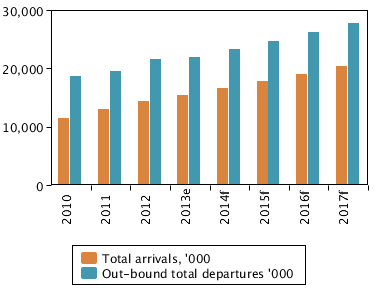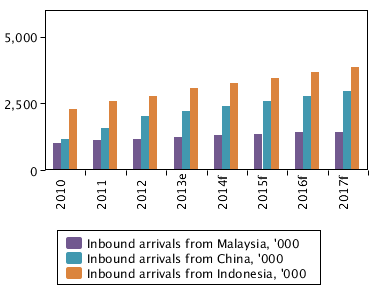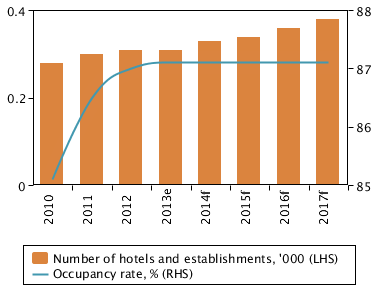While browsing, I came across an article on how tourism will play a significant part in growing Singapore. For those investors who are particularly vested with hospitality stocks such as Ascott, Far East Hospitality Trust, CDL Trust, this comprehensive report will be extremely helpful to you.
Tourism
Tourism in Singapore is well supported by the established transport infrastructure, and Changi International Airport is one of the world’s busiest, with more than 100 airlines and more than 6,000 weekly flights connecting Singapore to the Asia Pacific region and beyond. The airport handles around 50mn passengers a year and is undergoing major expansion that will allow it to benefit from anticipated tourism growth. Singapore also benefits from substantial sea connections via PSA Singapore Terminals, and modern road and rail networks.
The modern and efficient transport infrastructure means Singapore is advantageously placed to take advantage of increases in the tourism market, with inbound travel forecast to increase from 14.4mn in 2012 to 20.6mn in 2017. Outbound travel is also expected to increase, from 21.6mn annual departures in 2012 to 27.9mn in 2017. Considering Singapore’s relatively small population, this is a particularly impressive rate of outbound travel and reflects the strength of the market.
Singapore’s hotel market is already well developed, with most global hotel chains having at least some presence in the country. Despite limited real estate availability, the market is still appealing given the country’s openness to foreign investment and the stability of the domestic economy. We therefore expect to see year-on-year increases in the number of hotels throughout our forecast period to 2017. At the same time, we also expect to see strong growth in receipts from travel-related expenditure as more tourists arrive in Singapore and as outbound travel expands.

Inbound Arrivals
The majority of arrivals to Singapore are from Asia Pacific countries, with the region accounting for around 75% of arrivals by 2017. Following particularly high growth in 2010 and 2011 as major markets such as China experienced particularly buoyant economic expansion, we expect growth from the Asia Pacific region to slow but still remain strong over our 2013-2017 forecast period, between 5% and 9% per year. By 2017, we forecast that arrivals from the Asia Pacific region will surpass 14.9mn a year as increasing numbers of middle-class travellers in countries throughout the region have more disposable income for travel, and as travel links continue to improve.
Arrivals from the Middle East grew by an impressive 12.68% in 2013, as links between the Asia Pacific region and Singapore continued to thrive. Although growth is expected to slow, particularly towards the end of our forecast period when other destinations might replace Singapore in terms of popularity, we are still forecasting good growth overall, with arrivals from the region increasing from 144,690 in 2013 to 191,700 in 2017, representing a sizeable opportunity for growth.
Europe, and to a lesser extent North America, are also expected to show arrivals growth throughout the forecast period. Arrivals from North America in particular are expected to slow towards the end of the forecast period as the economy of the US continues to suffer from the effects of the global credit crunch. Europe is therefore expected to remain the second most popular region of origin for travellers to Singapore, accounting for more than 1.1mn visitors in 2017, an increase of around 200,000 on the 2013 figure.
Countries from within the Asia Pacific region account for nine out of the top 10 markets by arrivals to Singapore. Indonesia is expected to remain the number one country of origin, with arrivals forecast to grow from 3.1mn in 2013 to more than 3.8mn in 2017. Strong growth is expected from all countries, although a slower rate of growth in terms of arrivals from Japan (as the Japanese domestic economy is expected to show only limited economic growth in the next few years) will mean that Thailand moves up the top 10 table by 2017.
The only country from outside the Asia Pacific region to make it into the top 10 is the US. Singapore has long been a popular destination and transit hub for travellers from the US, both business- and tourism-orientated. We expect this to continue, with arrivals forecast to increase to more than 569,500 by 2017.

| 2010 | 2011 | 2012 | 2013e | 2014f | 2015f | 2016f | 2017f | |
|---|---|---|---|---|---|---|---|---|
| Indonesia | 2,305.15 | 2,592.22 | 2,798.28 | 3,081.53 | 3,272.58 | 3,475.97 | 3,686.07 | 3,868.91 |
| China | 1,171.34 | 1,577.52 | 2,033.44 | 2,249.43 | 2,417.10 | 2,595.61 | 2,793.16 | 2,970.64 |
| Malaysia | 1,036.92 | 1,140.94 | 1,178.27 | 1,269.70 | 1,325.47 | 1,380.97 | 1,426.00 | 1,456.33 |
| Australia | 880.49 | 956.04 | 1,023.97 | 1,053.49 | 1,090.78 | 1,130.02 | 1,167.82 | 1,196.44 |
| India | 828.90 | 868.99 | 898.55 | 968.28 | 1,040.83 | 1,127.00 | 1,225.93 | 1,304.24 |
| Japan | 528.82 | 656.42 | 744.05 | 762.24 | 767.81 | 778.27 | 784.63 | 789.27 |
| Philippines | 544.34 | 677.72 | 653.89 | 720.22 | 752.60 | 788.23 | 820.64 | 842.97 |
| US | 416.99 | 440.58 | 476.70 | 513.31 | 529.60 | 544.78 | 560.48 | 569.52 |
| Hong Kong | 387.55 | 464.38 | 475.77 | 524.16 | 550.08 | 575.61 | 604.31 | 627.33 |
| Thailand | 430.02 | 472.71 | 464.39 | 507.98 | 549.54 | 593.29 | 641.40 | 686.19 |
| e/f = BMI estimate/forecast. Source: BMI, Statistics Singapore | ||||||||
Hotels
As the number of tourists from outside Singapore increases, and domestic travel also expands, the country’s hotel infrastructure is expected to grow accordingly. From 2014 onwards, BMI therefore expects the number of hotels and establishments to increase at a rate of more than 5% per year, reaching over 3,800 hotels by 2017. This is remarkable considering the limited geographic scope of Singapore’s territory. The number of available rooms is expected to show a concurrent rise throughout the forecast period.
During this period we also expect the average length of stay to increase, and despite the increase in the number of hotels, the occupancy rate is also expected to remain steady at an impressive 87.1%. The high occupancy rate is a positive reflection of the potential for returns on investment in Singapore’s hotel industry, and is one of the highest occupancy rates in the Asia Pacific region.
| 2010 | 2011 | 2012 | 2013e | 2014f | 2015f | 2016f | 2017f | |
|---|---|---|---|---|---|---|---|---|
| Number of Hotels and establishments ‘000 | 0.28 | 0.30 | 0.31 | 0.31 | 0.33 | 0.35 | 0.36 | 0.38 |
| Number of Hotels and establishments ‘000 % change yoy | 5.22 | 7.80 | 1.32 | 1.30 | 5.13 | 5.18 | 5.51 | 5.22 |
| Average length of stay, nights | 3.90 | 3.70 | 3.81 | 3.85 | 3.86 | 3.87 | 3.87 | 3.87 |
| Average length of stay, nights, % change y-o-y | -2.50 | -5.13 | 3.08 | 0.97 | 0.32 | 0.10 | 0.03 | 0.01 |
| Hotel rooms ‘000 | 47.31 | 49.72 | 50.21 | 50.69 | 52.92 | 55.26 | 57.76 | 60.47 |
| Hotel rooms ‘000, % change y-o-y | 10.75 | 5.09 | 0.98 | 0.97 | 4.39 | 4.42 | 4.53 | 4.68 |
| Occupancy rate % | 85.10 | 86.50 | 87.00 | 87.08 | 87.09 | 87.10 | 87.10 | 87.10 |
| e/f = BMI estimate/forecast. Source: BMI, Statistics Singapore, Singapore Tourism Board. Occupancy rate = room occupancy | ||||||||

Tourism Industry Risk/Reward Ratings
This is an evaluation of the sector’s size and growth potential in each state, along with broader industry/state characteristics that may inhibit its development. The reward ratings for tourism take into account the numbers and percentage growth of tourist arrivals over the past year as well as our forecasts for growth over 2013 and 2014. Singapore has recently experienced steady growth in tourism arrivals, and while we expect this to continue, limitations in the international economy could depress figures. Overall tourism receipts and hotel occupancy were similarly enhanced and offset, and this has been factored in accordingly, giving Singapore a tourism market score of 71.67.
This is an evaluation of the sector’s size and growth potential in each state, along with broader industry/state characteristics that may inhibit its development. The reward ratings for tourism take into account the numbers and percentage growth of tourist arrivals over the past year as well as our forecasts for growth over 2013 and 2014. Singapore has recently experienced steady growth in tourism arrivals, and while we expect this to continue, limitations in the international economy could depress figures. Overall tourism receipts and hotel occupancy were similarly enhanced and offset, and this has been factored in accordingly, giving Singapore a tourism market score of 71.67.
| Rewards | Risks | |||||||
|---|---|---|---|---|---|---|---|---|
| Limits of potential returns | Tourism market | Country structure | Risks to realisation of potential returns | Market risks | Country risk | Tourism rating | Rank | |
| Hong Kong | 75.32 | 83.33 | 63.29 | 77.54 | 79.59 | 75.86 | 75.98 | 1 |
| Thailand | 75.99 | 85.30 | 62.04 | 60.75 | 68.09 | 54.74 | 71.42 | 2 |
| Australia | 65.83 | 61.67 | 72.06 | 82.42 | 78.40 | 85.72 | 70.80 | 3 |
| Singapore | 65.29 | 71.67 | 55.73 | 80.55 | 85.47 | 76.52 | 69.87 | 4 |
| Macau | 69.00 | 76.67 | 57.50 | 67.20 | 65.00 | 69.00 | 68.46 | 5 |
| South Korea | 67.93 | 66.67 | 69.83 | 66.51 | 70.39 | 63.33 | 67.50 | 6 |
| Taiwan | 68.62 | 75.00 | 59.04 | 64.09 | 73.21 | 56.63 | 67.26 | 7 |
| Vietnam | 61.91 | 61.67 | 62.26 | 55.57 | 65.19 | 47.70 | 60.00 | 8 |
| New Zealand | 49.88 | 26.67 | 84.69 | 83.25 | 76.65 | 88.66 | 59.89 | 9 |
| Malaysia | 54.33 | 50.00 | 60.83 | 66.94 | 74.10 | 61.09 | 58.11 | 10 |
| Myanmar | 55.82 | 51.67 | 62.04 | 61.63 | 62.39 | 61.00 | 57.56 | 11 |
| Sri Lanka | 57.66 | 60.00 | 54.14 | 50.31 | 63.77 | 39.29 | 55.45 | 12 |
| Japan | 48.12 | 29.17 | 76.55 | 68.87 | 70.08 | 67.88 | 54.35 | 13 |
| Philippines | 51.93 | 51.67 | 52.33 | 56.44 | 70.00 | 45.34 | 53.28 | 14 |
| Laos | 56.48 | 61.67 | 48.70 | 41.76 | 63.88 | 23.66 | 52.06 | 15 |
| China | 48.02 | 43.33 | 55.05 | 58.61 | 76.51 | 43.97 | 51.20 | 16 |
| Cambodia | 55.89 | 65.00 | 42.21 | 36.25 | 33.02 | 38.90 | 49.99 | 17 |
| India | 42.22 | 40.00 | 45.54 | 46.96 | 36.13 | 55.82 | 43.64 | 18 |
| Indonesia | 37.97 | 35.00 | 42.41 | 50.34 | 61.77 | 40.98 | 41.68 | 19 |
| Pakistan | 38.28 | 40.00 | 35.69 | 44.91 | 59.79 | 32.73 | 40.27 | 20 |
| Bangladesh | 36.01 | 25.00 | 52.53 | 45.98 | 68.12 | 27.87 | 39.00 | 21 |
| Source: BMI | ||||||||
The future of the tourism industry in Singapore is looking very positive. Increases in inbound and outbound travel, as well as improvements to the country’s transport infrastructure, investments in hotel expansions and higher travel receipts, will boost the overall industry value throughout our forecast period to 2017. With a strong domestic economy and stable political environment, the signs of growth make Singapore an attractive prospect for foreign direct investment.


Read in today's paper that FCL is likely to list a hospitality trust. Any thoughts?
Renewed investor
Hi Renewed Investor
Yes there has been news that FCL is going to list separately its hospitality business but nothing is concrete yet. Still need to see the properties included in the trust and how they are doing.
Somehow I feel that the Reits/Trusts listed in Singapore is getting more saturated. Everyone is almost listing it in Singapore so investors have more to choose from 😉
Hi B,
I tried to contact you some time back. I really enjoy your writings and would like to communicate with you. Could you email me? My email is [email protected]
Sincerely,
Wilson
This comment has been removed by the author.
Hi, I am currently doing a school project and came across your post.
May I ask if you have details about the forecast tourist revenue for the top 10 market?
Thanks
tourism, business & financial news Reporters At Large publishes the latest news from Nigeria and around the world, delivering online Nigerian & international breaking news in culture and tourism, business, politics, entertainment, science and technology, sports, video and pictures.